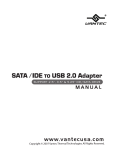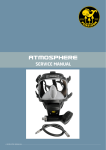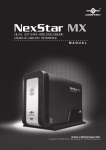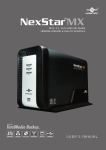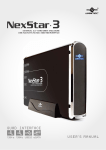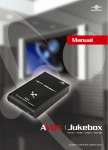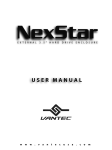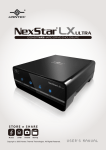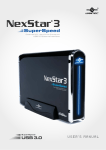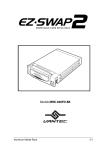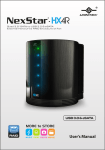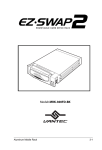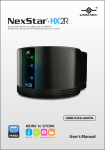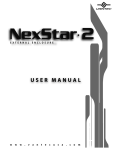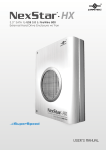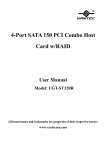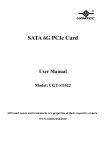Download Vantec NexStar MX NST-400MX-S2
Transcript
Table of Contents: 1. Introduction ...................................................................................................................................... pg. 2 2. Specifications/Features NexStar MX DUAL 3.5” SATA HDD Enclosure ............................................................................ pg. 3 3. System Requirements .................................................................................................................... pg. 4 4. Interface Information NexStar MX DUAL 3.5” SATA HDD Enclosure ............................................................................ pg. 5 5. Installation NexStar MX DUAL 3.5” SATA HDD Enclosure 5.1. Hardware Installation .................................................................................................... pg. 6 5.2. Driver Installation ............................................................................................................ pg. 8 6. Disconnecting the NexStar MX NexStar MX DUAL 3.5” SATA HDD Enclosure .......................................................................... pg. 10 7. Creating A New Partition .............................................................................................................. pg. 11 8. JBOD Configuration.........................................................................................................................pg.14 9. Troubleshooting/FAQ NexStar MX DUAL 3.5” SATA HDD Enclosure .......................................................................... pg. 15 10. Warranty ............................................................................................................................................ pg. 16 11. Contact ............................................................................................................................................. pg. 17 Table of Contents 1 1. Introduction: Vantec NexStar MX Dual Bay External Hard Drive Enclosure is a quick and simple way to expand storage capacity to your computer. It comes without the hassle of diving inside the PC and messing with all the wires, cables and connections. The sturdy drive cage protects your hard drive while the stylish aluminum case effectively draws away the heat; the front vents and rear fan keep your hard drive(s) cool and improve performance. Add two independent SATA I/II hard drives or configure into a single JBOD drive for up to 2 terabytes of drive space. Easy-to-use Arcsoft Totalmedia Backup™ software allows you to archive precious family photos, music, videos, and games with three easy clicks. The Vantec NexStar MX Dual is a high performance, capacity, and durable storage solution and lets your store your personal data in an enclosure with style! Introduction 2 2. Specifications/Features: NexStar MX Dual 3.5” SATA HDD Enclosure: SPECIFICATIONS: Application: 3.5” SATA hard drive (x2) Interface/Ports: Serial ATA (Internal), USB 2.0 (External) Windows Requirements: USB 2.0: Windows 98SE/ME/2000/XP USB 1.1: Windows 98SE/ME/2000/XP Mac Requirements: USB 2.0: Mac OS 10.2 or higher USB 1.1: Mac OS 9.1 or higher Power Supply: Universal auto-switching external power adapter Input: AC 100-240V, 1.2A, 50-60Hz Output: DC +5/1.5A, +12V/1.5A Enclosure Dimensions: 197 x 123 x 72mm FEATURES: 2.0 TB of Storage Supports 2 SATA I/II Hard Drives Up to 2.0 TB of Storage. Air Circulation & Cooling Front Ventilation and Rear Fan for Better Air Circulation and Cooling. Aluminum Casing Stylish Aluminum Case to Draw Away the Heat. Simple Plug & Play Simple Plug & Play Connection; Does Not Require Drivers. JBOD Configuration Combining Multiple Physical Disks Drives into a Single Virtual One. Specifications/Features 3 3. System Requirements: • • • • • Intel Pentium II 350MHz-compatible or Apple G3 processor and greater Microsoft Windows 98SE/ME/2000/XP or Mac OS 9.1 and greater USB-equipped system with available USB port For USB 2.0 speeds, the system must support USB 2.0 specifications CD Rom drive (if drivers are needed) System Requirements 4 4. Interface Information: NexStar MX Dual 3.5” SATA HDD Enclosure: Fan On/Off Switch USB port to PC/Mac Power Connector On/Off Switch Exhaust Fan Vent USB Port Connect to a computer directly using a USB cable. Fan Automatic fan to keep the hard drives cool. Interface Information 5 5. Installation: NexStar MX Dual 3.5” HDD Enclosure: 5.1. Hardware Installation: Preparing the NexStar MX: 1) Release the 2 screws then pull out the rear panel and tray of the NexStar MX Dual Installing two hard drives into the NexStar MX Dual: 1) Place the first HDD onto the drive caddy then insert the HDD into the SATA connector. Installation 6 2) Place the second HDD onto the drive caddy then insert the HDD into the SATA connector. 3) Secure the hard drives onto the drive caddy with screws provided. 4) Insert the drive caddy back into the aluminum houing. Be sure to align and secure with the screws provided. Installation 7 Connecting the NexStar MX Dual to your computer: 1) Connect the type B USB connector to the NexStar MX Dual and the type A USB connector to an available USB 1.1/2.0 port on your system. 2) Connect the power cable to the NexStar MX Dual and plug the cable into an available outlet. 3) Turn on the NexStar MX Dual via the power switch. 4) Your operating system should detect the NexStar MX Dual and automatically install the necessary drivers (if you have Windows 98SE/MacOS 8.6, you will need to install drivers). Once your operating system finishes setting up the NexStar MX Dual, it will mount your hard drive. On Mac OS systems, the new volume should appear on the desktop. On a Windows PC, the new volume will appear under My Computer. NOTE: For new hard drives, you will need to initialize and partition your hard drive before it will appear in Windows Explorer or on your Mac desktop. Please refer to your hard drive manufacturer’s documentation or read the “Creating a New Partition” section of this manual. 5) Your NexStar MX Dual External Hard Drive is now ready for use. 5.2. Driver Installation: Windows ME/XP/2000 1) No drivers are necessary when using Windows ME/XP/2000. If the hard drive does not appear under My Computer, be sure to partition your hard drive. Windows 98SE 1) The first time you plug in the NexStar MX Dual into a USB port of your computer, the [Add New Hardware Wizard] dialog box will appears. 2) Click on [Next]. Check the [Search for the best driver for your device] and click on [Next] again. 3) Insert the device driver CD into your CD-ROM drive if you have not already done so and click on [Next], a screen should be appears to show which Storage Device you installed. Click on [Next]. 4) After the needed files are copied into your system, click on [Finish]. 5) You should now be able to see the new hard drive under My Computer. A green Unplug or Eject hardware icon will appear in the system tray as well. If the drive does not appear, you may need to partition your hard drive first. Installation 8 Mac OS 9.0 or later: 1) No drivers are necessary when using Mac OS 9.0 or later. If the hard drive does not appear on the desktop, be sure to partition your hard drive. Mac OS 8.6: 1) Unplug the NexStar MX Dual if you currently have it connected. 2) USB Mass Storage Support 1.3.5 must be installed on your system. If it is not, you can download the USB Mass Storage Support 1.3.5 from the Apple Software Updates website: http://www.apple.com/support 3) Follow the direction associated with the USB Mass Storage Support driver to install 4) Repeat the steps listed under “Connecting the NexStar MX Dual to your computer.” Installation 9 6. Disconnecting the NexStar MX DUAL: NexStar MX Dual 3.5” HDD Enclosure: Warning: NEVER remove the NexStar MX Dual while the hard drive is in use. Doing so may corrupt the data on the hard drive or damage the hard drive, NexStar MX Dual, or computer. Windows 98SE/ME/XP/2000: 1) Make sure all operations using the hard drive within the NexStar MX Dual has ceased. 2) Close any windows and programs pertaining to the NexStar MX Dual. 3) If connected by USB, double click the green “Unplug or Eject Hardware” icon in the system tray and select [Safely Remove Hardware]. Select the device you wish to remove and click on [Stop]. The system should prompt, “It is now safe to remove the USB device.” If not, wait for any programs still using the device to finish and try again. 4) Turn off the NexStar MX Dual. 5) Unplug the USB cable from the system. Mac OS: 1) Make sure all operations using the hard drive within the NexStar MX Dual has ceased. 2) Close any windows and programs pertaining to the NexStar MX Dual. 3) From the Desktop, drag the NexStar MX Dual hard drive to the trash. 4) Turn off the NexStar MX Dual. 5) Unplug the USB cable from the system. Disconnecting the NexStar MX Dual 10 7. Creating A New Partition: Note: Most hard drives should come with a CD that includes its installation program. If not, a download should be available on the manufacturers website. The best way to partition a new hard drive is by using the manufacturers program. However, if that is not possible, please try the following instead (if using Mac OS 9 or below, please refer to your hard drive documentation for information on formatting/partitioning the hard drive): Warning: Doing the following will erase any existing data on the drive. If the drive is damaged and you wish to recover the data, continuing may overwrite the existing information! Windows 98SE/ME: 1) You will need to use the FDISK utility that is included under MS-DOS. Please refer to Microsoft Knowledge Base Article – 255867 for complete instructions on how to use FDISK. (http://support.microsoft.com/support/kb/articles/Q255/8/67.ASP) 2) Once complete, you should now be able to see the drive in Windows Explorer. Windows XP/2000: 1) Right click on "My Computer" and choose Manage. 2) Under “Storage” on the LEFT pane, select Disk Management 3) Windows should now give you the option to initialize the disk. If not, locate the new drive, right click on the new disk (where it reads "Disk #") and choose Initialize. (This step may not be required for some hard drives.) 4) Go through the wizard. 5) Once complete, locate your hard drive in the bottom right pane. Right click on the area with a status bar (to the right of the “Disk #” area) and choose New Partition. 6) Follow the directions of the wizard. The recommended partition type is “primary” and the recommended file system is “NTFS.” Please note that Windows XP/2000 limits FAT32 partitions to only 32GB. Also, Windows 98 is not capable of reading the NTFS file system. (FULL format for new hard drive.) 7) Once format complete you should now be able to see the drive in Windows Explorer. Creating a New Partition 11 Mac OS X 10.x.x: Initializing a Hard Drive: If you are using a new hard drive, you may need to initialize it first. You can initialize your internal hard drive using a program called Drive Setup, which is on the Mac OS CD that came with your computer. 1. Start up your computer from the Mac OS CD. 2. Locate the Utilities folder on the Mac OS CD and double-click it to open the folder. 3. Double-click the Drive Setup icon to open the program. 4. In the list of drives, select the drive you want to initialize. 5. Click Initialize. To format your hard drive with Mac OS Extended format, a method of formatting hard drives that allows for more efficient use of hard drive storage space, follow the steps below: 1. Click Custom Setup. 2. Select the desired partitioning scheme. 3. Open the Type pop-up menu in the Volume Info area and choose Mac OS Extended Format. 4. Resize the volumes if desired. 5. When ready, click OK. 6. Click Initialize. If initialization fails, do the following: 1. Choose Initialization Options from the Functions menu. 2. Click the checkbox next to "Low level format", then click OK. Choosing this option adds significant time to the initialization process. Creating a New Partition 12 Mac OS X 10.x.x: Formatting a Hard Drive: 1. Start the Disk Utility tool (under Applications) 2. Select the new hard drive you are trying to install 3. Click on the “Erase” tab 4. Choose a volume format and assign a name to the new drive. 5. Click on Erase. 6. Once complete, your new hard drive should be mounted on your desktop. Creating a New Partition 13 8. Troubleshooting/FAQ: NexStar MX Dual 3.5” HDD Enclosure: Q. My computer recognizes the NexStar MX Dual, but it does not assign a drive letter to it. A. You are probably using a brand new hard drive. If not, then your computer may not be able to recognize the partition on the hard drive because it is damaged or not a valid format. Please refer to the section “Creating A New Partition” for information on how to create a useable partition on your drive. Q. My computer sometimes recognizes the NexStar MX Dual, but sometimes gives me errors. A. If your computer is giving you problems with the NexStar MX Dual, be sure to connect the USB cable to a rear port, directly off the motherboard or USB PCI card. The cables connecting front USB ports are not always properly shielded and cannot properly handle USB 2.0 speeds, thereby corrupting the signal between the NexStar MX Dual and the computer. Q. Why is the data on my hard drive corrupted? A. Connecting your hard drive to the NexStar MX Dual is just like connecting a hard drive to the inside of your computer. The NexStar MX Dual itself will not corrupt your data. If your data has become corrupt, it is likely caused by the removal of the NexStar MX Dual while data was still being written to the hard drive. CAUTION: Never remove the NexStar MX Dual while data is being written to the hard drive! Doing so may cause the hard drive to become corrupt. Make sure all applications being run off the disk and all files in use are no longer in use before removing the unit. Q. Why is my computer not showing the full size of my hard drive? A. If you are using Windows 98SE, please refer to Microsoft’s Windows 98 Support Center and download the large capacity drive patch. Else, verify that your motherboard supports large capacity drives. Some older motherboards cannot use drives larger than 137 GB. If Windows XP/2000 will not let you create a partition larger than 32GB, make sure you are using the NTFS file system, as Windows XP/2000 limits FAT32 partitions to only 32GB. Troubleshooting/FAQ 14 Q. Why can’t Windows 98SE read my hard drive? It works with Windows XP/2000. A. Windows 98SE cannot recognize the NTFS file system. If you wish to use the device with Windows XP/2000 and Windows 98SE, you need to format the drive as FAT32. Q. Why can’t I copy files larger than 4GB onto my NexStar MX Dual? A. You have probably formatted the hard drive in the FAT32 file system. FAT32 limits the file sizes to 4GB maximum. The NTFS file system does not have this limitation. Q. What is JBOD? A. JBOD (for "just a bunch of disks," or sometimes "just a bunch of drives") is a derogatory term - the official term is "spanning" - used to refer to a computer's hard disks that haven't been configured according to the RAID (for "redundant array of independent disks") system to increase fault tolerance and improve data access performance. The RAID system stores the same data redundantly on multiple disks that nevertheless appear to the operating system as a single disk. Although, JBOD also makes the disks appear to be a single one, it accomplishes that by combining the drives into one larger logical one. Troubleshooting/FAQ 15 9. Warranty: The NexStar MX Dual comes with a 1 year limited warranty (90 day parts). If your unit should become defective within that time frame, please go to http://www.vantecusa.com for information on how to receive warranty exchange or repair. Cosmetic defects and missing parts are not covered under this warranty. Please check the contents of the unit to make sure you received all parts. Also, check for any cosmetic flaws. If any parts are missing or if there are cosmetic defects, please contact the retailer from which you purchased the unit immediately and ask for a replacement. 10. Contact: Vantec Thermal Technologies 43951 Boscell Rd. Fremont, CA 94538 tel: 510-668-0368 fax: 510-668-0367 website: www.vantecusa.com Warranty/Contact 16

















